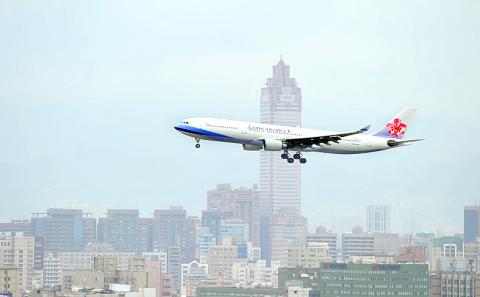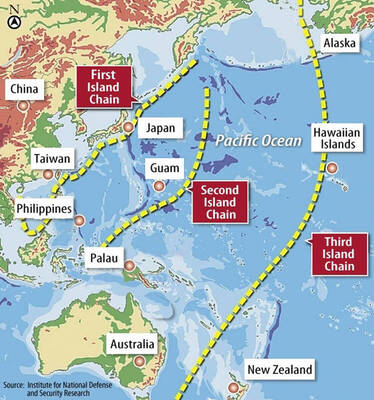Direct flights between the city airports of Taipei and Tokyo resumed yesterday after a hiatus of 31 years, marking a major milestone in Taipei’s ambition to become part of a golden flight circuit connecting Northeast Asia’s major metropolitan areas.
A total of 245 passengers, including Taipei Mayor Hau Lung-bin (郝龍斌), set off on the inaugural flight from Taipei International Airport (Songshan) to Tokyo’s Haneda Airport at 7:30am.
Hau said at a ceremony at Taipei International Airport before the EVA Airways Airbus 330 departed that he believed the resumption of Songshan-Haneda flights, one of President Ma Ying-jeou’s (馬英九) major policy goals when he was Taipei mayor, would transform the airport into a “capital city business airport.”

PHOTO: CNA
The government has positioned the airport as a key link in a “Northeast Asia Golden Flight Circuit” of city airports in Taipei, Seoul, Shanghai and Tokyo.
The new flight route is expected to stimulate business travel between the two cities by saving travel time on the ground and baggage pick-up at the airports.
By leaving from the city airport rather than from Taiwan Taoyuan International Airport, travelers who live in Taipei could save up to 40 minutes transiting to the airport.
Likewise, landing at Tokyo’s Haneda Airport rather than at the more common destination for international flights, Narita International Airport, travelers could save at least 30 minutes on the commute into Tokyo.
Taipei International Airport was once the country’s only international gateway and offered direct flights to Haneda until 1979, when the then-named Taoyuan International Airport opened to handle international flights.
Tseng Mao-pin (曾茂彬), a 77-year-old retired umbrella -manufacturer who lives in Taipei County’s Yonghe (永和), said he used to fly the -Songshan-Haneda route on business when he was young.
“I’m excited to go to see my old friends in Japan again, this time on the first Songshan-Haneda flight,” Tseng said, explaining why he booked a seat on the flight.
Other travelers, however, said they were confused, because they were more familiar with Taiwan Taoyuan International Airport.
Jennifer Chan, who traveled with 43 members of a mountaineering club from Taichung City, said they left home at 2am without knowing that their travel agent had arranged for them to take the historic flight.
“I still prefer Taoyuan Airport, not only because it takes longer to get to Taipei than to Taoyuan,” Chan said. “But it’s really too small here, plus the ceiling is incredibly low.”
To celebrate the resumption of direct flights between the two gateways, 12 Japanese with the same names as the names of city airports in Taipei and Tokyo were flown for free between the two cities yesterday.
The promotion, co-sponsored by the Tourism Bureau and China Airlines, offered the passengers surnamed “Matsuyama” (or Songshan in Chinese) and “Haneda” free same-day round-trip travel between Haneda and Songshan airports and a day tour in Taipei.
The China Airlines flight that left Haneda at 7am was the first to fly from the Tokyo city airport to the Taipei City airport.
Keiko Matsuyama, a 37-year-old businesswoman, said she was “amazed” to learn that her last name had the same characters as the Taipei airport and she was eager to enjoy her day in the city.
“I am looking forward to having a massage and some hsiaolungpao [steamed dumplings],” she said.
Matsuyama also praised the Taipei International Airport for its convenient downtown location and quick service compared with Taiwan Taoyuan International Airport, saying it took only five minutes for her luggage to be delivered.
Matsuyama and her fellow travelers were scheduled to return to Tokyo on a flight departing from Songshan at 6:15pm yesterday.
Another 24 Tokyo metropolitan councilors were also on the China Airlines flight from Haneda and will visit the Taipei City Council and the Presidential Office during a three-day trip.
A total of 56 round-trip flights a week between Songshan and Haneda airports will be offered by four carriers — China Airlines, EVA Airways, Japan Airlines and All Nippon Airways.
They said round-trip fares will be about NT$14,000, with stays of up to 30 days allowed.
According to the Tourism Bureau, 780,000 Japanese travelers visited Taiwan between January and September, 19.45 percent more than in the same period last year.
During the same period, 1 million Taiwanese travelers visited Japan, a 26 percent year-on-year rise.
To promote the 2010-2011 Taiwan-Japan tourism exchange year, the authorities concerned said they hoped to increase the number of people traveling between the two countries annually from the current 2 million people to 3 million.

The US government has signed defense cooperation agreements with Japan and the Philippines to boost the deterrence capabilities of countries in the first island chain, a report by the National Security Bureau (NSB) showed. The main countries on the first island chain include the two nations and Taiwan. The bureau is to present the report at a meeting of the legislature’s Foreign Affairs and National Defense Committee tomorrow. The US military has deployed Typhon missile systems to Japan’s Yamaguchi Prefecture and Zambales province in the Philippines during their joint military exercises. It has also installed NMESIS anti-ship systems in Japan’s Okinawa

‘WIN-WIN’: The Philippines, and central and eastern European countries are important potential drone cooperation partners, Minister of Foreign Affairs Lin Chia-lung said Minister of Foreign Affairs Lin Chia-lung (林佳龍) in an interview published yesterday confirmed that there are joint ventures between Taiwan and Poland in the drone industry. Lin made the remark in an exclusive interview with the Chinese-language Liberty Times (the Taipei Times’ sister paper). The government-backed Taiwan Excellence Drone International Business Opportunities Alliance and the Polish Chamber of Unmanned Systems on Wednesday last week signed a memorandum of understanding in Poland to develop a “non-China” supply chain for drones and work together on key technologies. Asked if Taiwan prioritized Poland among central and eastern European countries in drone collaboration, Lin

TRAGEDY STRIKES TAIPEI: The suspect died after falling off a building after he threw smoke grenades into Taipei Main Station and went on a killing spree in Zhongshan A 27-year-old suspect allegedly threw smoke grenades in Taipei Main Station and then proceeded to Zhongshan MRT Station in a random killing spree that resulted in the death of the suspect and two other civilians, and seven injured, including one in critical condition, as of press time last night. The suspect, identified as a man surnamed Chang Wen (張文), allegedly began the attack at Taipei Main Station, the Taipei Fire Department said, adding that it received a report at 5:24pm that smoke grenades had been thrown in the station. One man in his 50s was rushed to hospital after a cardiac arrest

ON ALERT: Taiwan’s partners would issue warnings if China attempted to use Interpol to target Taiwanese, and the global body has mechanisms to prevent it, an official said China has stationed two to four people specializing in Taiwan affairs at its embassies in several democratic countries to monitor and harass Taiwanese, actions that the host nations would not tolerate, National Security Bureau (NSB) Director-General Tsai Ming-yen (蔡明彥) said yesterday. Tsai made the comments at a meeting of the legislature’s Foreign Affairs and National Defense Committee, which asked him and Minister of National Defense Wellington Koo (顧立雄) to report on potential conflicts in the Taiwan Strait and military preparedness. Democratic Progressive Party (DPP) Legislator Michelle Lin (林楚茵) expressed concern that Beijing has posted personnel from China’s Taiwan Affairs Office to its